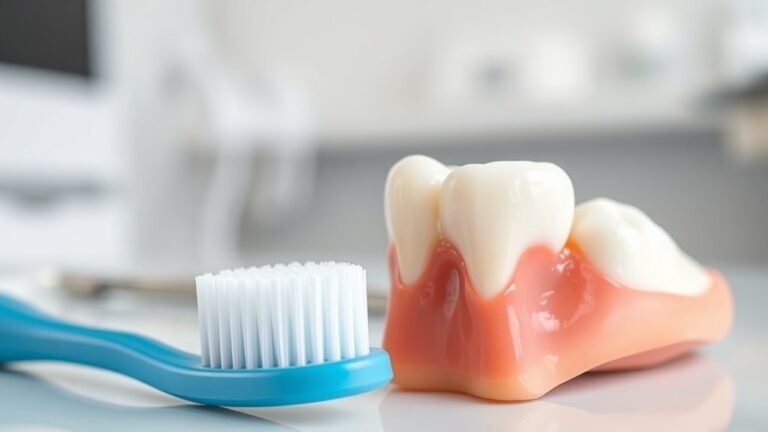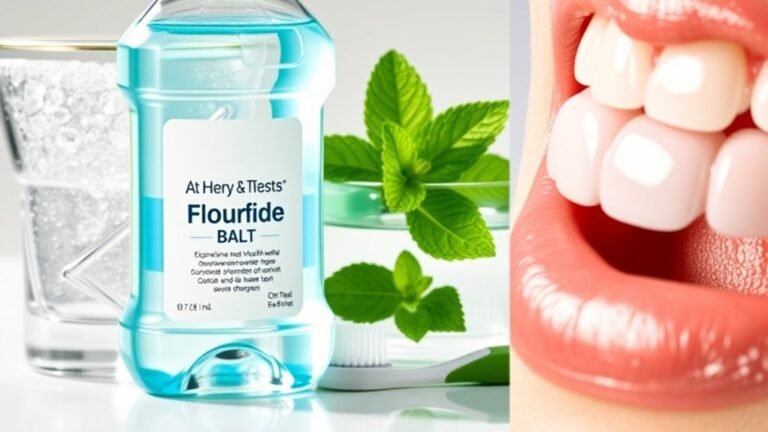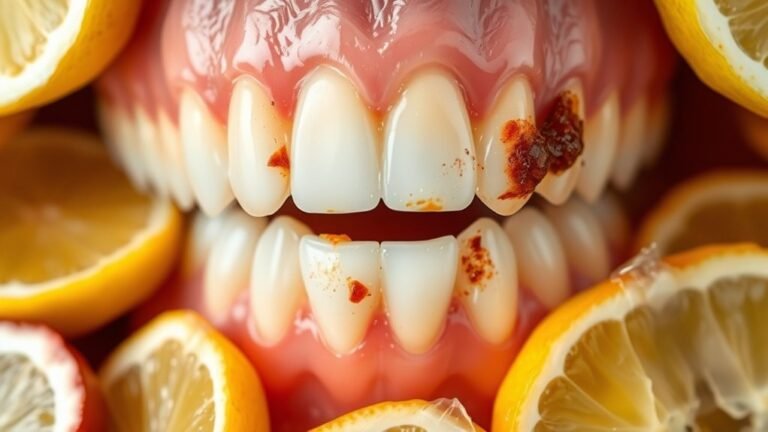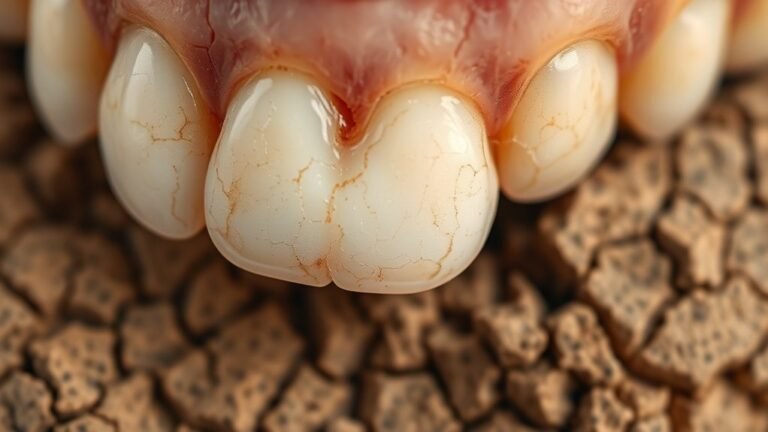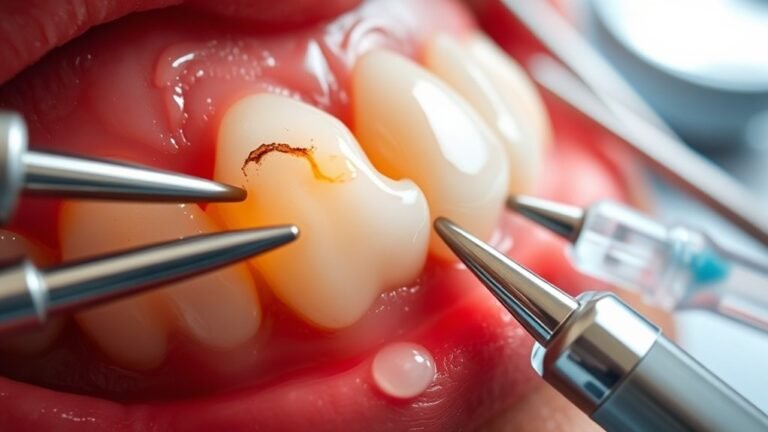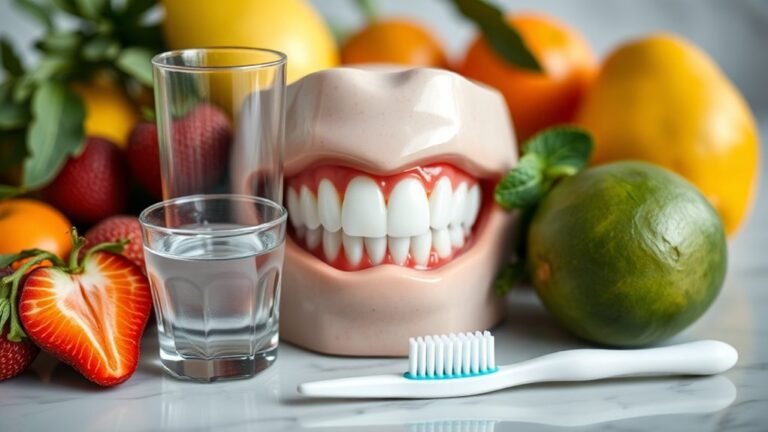Overbrushing With a Hard Brush Causes Enamel Erosion and Worsens Sensitivity
Overbrushing with a hard brush can seriously harm your enamel, making it wear away and exposing sensitive dentin. This leads to increased tooth sensitivity, especially to temperature and sugary foods. Hard-bristled toothbrushes can damage your gums and create rough patches on your teeth’s surface. To protect your oral health, opt for a soft-bristled toothbrush and use gentle techniques. Curious about effective brushing practices and dental care products? There’s more you can do to maintain a healthy smile.
Key Takeaways
- Overbrushing with a hard-bristled toothbrush can wear away enamel, leading to increased tooth sensitivity and potential damage to gums.
- The excessive pressure from hard brushes exacerbates enamel erosion and may expose underlying dentin, heightening sensitivity.
- Gentle brushing techniques with soft-bristled toothbrushes effectively clean teeth without risking enamel erosion or causing discomfort.
- Maintaining a proper brushing angle and light pressure can help preserve enamel while ensuring effective plaque removal.
- Regular dental check-ups can monitor enamel health and provide personalized advice to prevent sensitivity and erosion from overbrushing.
Understanding Enamel Erosion
While you may not realize it, enamel erosion is a common dental issue that can lead to serious consequences for your oral health. This process occurs when acids wear away the enamel, the protective outer layer of your teeth. As enamel erodes, you may experience increased tooth sensitivity, particularly when consuming hot, cold, or sweet foods. Dentin exposure, resulting from enamel loss, can make your teeth more vulnerable to decay and discomfort. Factors contributing to enamel erosion include acidic foods, beverages, and poor oral hygiene habits. It’s essential to recognize these signs early and consult your dentist for proper evaluation and care. By taking proactive measures, you can help protect your enamel and maintain a healthy smile.
The Impact of Overbrushing
Overbrushing can significantly contribute to enamel erosion, often going unnoticed by many individuals. When you use a hard-bristled toothbrush and apply excessive pressure, you’re not just removing plaque; you’re also wearing away your enamel. This protective layer is essential for maintaining your dental health, and without it, you may experience increased sensitivity and a higher risk of cavities. While you might believe that vigorous brushing is vital for good oral hygiene, it can actually do more harm than good. Instead, focus on gentle, thorough cleaning techniques. Adopting a softer approach will help preserve your enamel and overall dental well-being. Remember, maintaining effective oral hygiene doesn’t mean sacrificing your enamel health through overbrushing.
Hard-Bristled Brushes vs. Soft-Bristled Brushes
When choosing a toothbrush, the bristle type greatly impacts your dental health. Hard-bristled brushes can cause enamel erosion and gum damage, while soft-bristled brushes are often recommended for effective cleaning without harming your teeth. Understanding the best brushing techniques can help you maintain your oral health and prevent overbrushing.
Brush Bristle Impact
Choosing the right toothbrush bristle type can greatly affect your oral health, especially when it comes to enamel preservation. Hard-bristled brushes may seem effective, but they can contribute to enamel erosion and increased sensitivity. Opting for a soft-bristled brush is often the better choice for dental care. Here are some key points to examine:
- Soft bristles clean effectively without damaging enamel.
- They’re gentler on gums, reducing the risk of irritation.
- Soft brushes help minimize tooth sensitivity over time.
- They adapt better to the contours of your teeth, ensuring thorough cleaning.
- Most dental professionals recommend soft bristles for everyday use.
Recommended Brushing Techniques
Effective brushing techniques can make a significant difference in maintaining your dental health, particularly when deciding between hard-bristled and soft-bristled brushes. Soft-bristled brushes are generally recommended for daily use, as they effectively clean teeth without damaging enamel or irritating gums. They also allow for the application of fluoride toothpaste, which aids in cavity prevention. If you’re experiencing sensitivity, consider using toothpaste with potassium nitrate, which helps alleviate discomfort. Hard-bristled brushes can be too abrasive, leading to enamel erosion and increased sensitivity over time. By choosing the right brush and technique, you can enhance your oral care routine and protect your smile from potential issues. Remember, gentle brushing combined with fluoride and potassium nitrate can maximize your dental health.
Signs of Enamel Erosion
Although enamel erosion can occur gradually, recognizing the signs early is crucial for preserving your dental health. Pay attention to these indicators that may signal enamel erosion:
Recognizing early signs of enamel erosion is essential for protecting your dental health. Stay vigilant!
- Increased tooth sensitivity, especially to hot, cold, or sweet foods
- Yellowing of teeth as the dentin beneath the enamel becomes more visible
- Transparent edges on your teeth, particularly at the tips
- Chips or cracks forming on tooth surfaces
- A change in tooth texture, feeling rough or more porous than usual
If you notice any of these signs, it’s important to consult your dentist. Early intervention can prevent further damage and help maintain your overall oral health. Don’t ignore the warning signs—your enamel deserves protection!
How Enamel Erosion Affects Sensitivity
When enamel erosion occurs, it can considerably heighten tooth sensitivity, making everyday activities like eating and drinking uncomfortable. As enamel wears away, it exposes the underlying dentin, which contains tiny nerve endings. These exposed nerves can react sharply to temperature changes or certain foods, leading to pain or discomfort. You might notice sensitivity when consuming hot, cold, or sweet items, which can detract from your quality of life. Additionally, the loss of enamel diminishes your teeth’s protective barrier, making them more susceptible to cavities and decay. Addressing enamel erosion promptly is essential to manage sensitivity effectively and maintain your oral health. Regular check-ups can help monitor your enamel and provide guidance on maintaining your dental well-being.
The Importance of Proper Brushing Technique
Proper brushing technique is essential for maintaining your oral health and preventing issues like enamel erosion. By brushing effectively, you can minimize the risk of damaging your enamel and guarantee your teeth stay strong and healthy. Here are some key points to take into account:
Proper brushing technique is crucial for your oral health, helping prevent enamel erosion and ensuring strong, healthy teeth.
- Use a soft-bristled toothbrush to reduce abrasion.
- Position the brush at a 45-degree angle to your gums.
- Apply gentle pressure and use short, circular motions.
- Brush for at least two minutes, making sure all surfaces are covered.
- Replace your toothbrush every three to four months.
Following these guidelines will help you maintain a balanced approach to oral hygiene, reducing sensitivity and preserving your enamel for the long term. Remember, your technique matters!
Recommended Brushing Practices
To maintain ideal oral health, it’s essential to choose the right toothbrush and employ a gentle brushing technique. You should also pay attention to the timing and duration of your brushing sessions. Following these recommended practices can help prevent enamel erosion and promote better dental hygiene.
Choose the Right Brush
Choosing the right toothbrush is crucial for maintaining your dental health while preventing enamel erosion. When selecting a toothbrush, consider these key factors:
- Bristle Type: Opt for soft bristles to minimize gum irritation and enamel wear.
- Head Size: Choose a brush with a head size that comfortably fits your mouth, allowing access to all areas.
- Handle Grip: Look for a handle that offers a secure grip, which aids in effective brushing.
- Electric vs. Manual: Decide between electric or manual based on your personal preference and brushing effectiveness.
- ADA Seal of Acceptance: Verify your toothbrush has the American Dental Association (ADA) seal, which guarantees safety and efficacy.
Making the right choice can markedly impact your oral health.
Gentle Brushing Technique
While brushing your teeth, employing a gentle technique is vital to protect your enamel and gums. Use a soft-bristled toothbrush and hold it at a 45-degree angle to your gum line. This position allows the bristles to effectively clean without causing damage. Focus on short, circular motions rather than aggressive scrubbing, which can lead to enamel erosion. Make certain to brush all surfaces of your teeth, including the outer, inner, and chewing areas. Don’t forget to gently brush your tongue, as it can harbor bacteria. Aim to spend about two minutes brushing to guarantee thorough cleaning, but remember to keep the pressure light. This approach will help maintain your dental health and minimize sensitivity.
Timing and Duration
Although many people overlook the timing of their brushing, it’s vital for maintaining ideal dental health. Proper timing and duration can notably impact the effectiveness of your oral hygiene routine. Here are some recommended practices to take into account:
- Brush twice a day: Once in the morning and once before bedtime.
- Wait 30 minutes after eating: This helps protect enamel, especially after consuming acidic foods.
- Brush for at least two minutes: Guarantee you cover all surfaces thoroughly.
- Use a soft-bristled toothbrush: This minimizes the risk of enamel erosion.
- Replace your toothbrush every three to four months: A worn brush is less effective.
Alternative Dental Care Products
As you explore alternative dental care products, you’ll find a range of options designed to enhance oral health without the risks associated with overbrushing and enamel erosion. Consider using soft-bristle toothbrushes, which effectively clean without damaging enamel. Additionally, look for fluoride-free toothpaste made with natural ingredients, as they can help reduce sensitivity while maintaining a healthy mouth. Mouth rinses with essential oils or herbal extracts can provide antibacterial benefits without harsh chemicals. You might also want to try interdental brushes or flossers that promote better plaque removal between teeth. Natural tongue scrapers can aid in reducing bacteria and bad breath. By incorporating these products into your routine, you can support your dental health while minimizing the impact of abrasive practices.
Regular Dental Check-Ups and Their Role
Incorporating alternative dental care products into your routine is a great step towards maintaining oral health, but regular dental check-ups are just as important. These visits guarantee that your teeth and gums receive professional attention, helping to prevent and address issues before they escalate. During check-ups, your dentist can:
- Identify early signs of enamel erosion
- Monitor gum health and detect periodontal disease
- Provide personalized oral hygiene advice
- Perform professional cleanings to remove plaque and tartar
- Offer treatments tailored to your specific needs
Tips for Maintaining a Healthy Smile
To maintain a healthy smile, it’s essential to choose the right toothbrush and practice gentle brushing techniques. Opt for a soft-bristled brush to protect your enamel while effectively cleaning your teeth. By brushing gently, you can avoid damaging your gums and preserve your oral health.
Choose the Right Toothbrush
Choosing the right toothbrush can greatly impact your oral health and help prevent issues like enamel erosion. A suitable toothbrush not only cleans effectively but also protects your teeth and gums. Here are some tips to guide your selection:
- Bristle Type: Opt for soft bristles to minimize enamel wear and gum irritation.
- Size: Choose a brush head that comfortably fits your mouth for better access to all areas.
- Handle: Look for a non-slip, ergonomic handle that provides a comfortable grip.
- Electric vs. Manual: Consider an electric toothbrush for more consistent brushing pressure and technique.
- ADA Seal: Verify the toothbrush has the American Dental Association (ADA) Seal of Acceptance for quality assurance.
Making the right choice can lead to a healthier smile.
Practice Gentle Brushing Techniques
Using the right toothbrush sets the foundation for effective oral care, but practicing gentle brushing techniques is just as important for maintaining a healthy smile. Here are some tips to help you brush effectively without damaging your enamel:
| Technique | Description | Benefits |
|---|---|---|
| Soft Circular Motions | Use gentle, circular motions to clean teeth. | Reduces enamel wear. |
| Light Pressure | Apply minimal pressure while brushing. | Decreases sensitivity. |
| Two Minutes | Brush for a full two minutes, twice a day. | Guarantees thorough cleaning. |
| Angled Brush | Hold your brush at a 45-degree angle. | Targets gumline effectively. |
Frequently Asked Questions
Can Enamel Erosion Be Reversed or Healed Naturally?
Enamel erosion can’t be fully reversed naturally, but you can strengthen your enamel through a balanced diet rich in calcium and phosphorus, fluoride treatments, and by practicing good oral hygiene. Regular dental check-ups are essential, too.
How Often Should I Replace My Toothbrush?
You should replace your toothbrush every three to four months. Notably, worn bristles clean less effectively; studies show that 70% of people don’t change theirs frequently enough, risking their oral health. Stay proactive and swap it out!
Does Diet Impact Enamel Health Significantly?
Yes, your diet greatly impacts enamel health. Consuming acidic foods and sugary beverages can erode enamel, while a balanced diet rich in calcium, phosphorus, and vitamins strengthens it. Prioritize nutrient-dense foods for better oral health.
Are There Any Home Remedies for Sensitivity Relief?
Yes, you can try several home remedies for sensitivity relief. Rinsing with warm saltwater, using fluoride toothpaste, or applying a mixture of clove oil and coconut oil can help soothe discomfort and strengthen enamel.
What Are the Long-Term Effects of Enamel Erosion?
Imagine your favorite mug slowly losing its shine. Enamel erosion can lead to increased sensitivity, cavities, and discoloration. It also exposes dentin, making your teeth more vulnerable to decay and discomfort over time. Protect your smile!
Conclusion
To keep your smile sparkling and your teeth happy, remember that gentle brushing is key. Overbrushing with a hard brush can wear away your enamel and heighten sensitivity, so opt for a soft-bristled brush instead. By following recommended brushing practices and choosing the right dental care products, you can protect your teeth effectively. Regular check-ups with your dentist will guarantee your oral health remains in top shape, helping you maintain that bright and confident smile you cherish.

